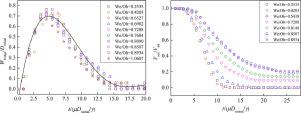International Journal of Multiphase Flow ( IF 3.8 ) Pub Date : 2021-03-13 , DOI: 10.1016/j.ijmultiphaseflow.2021.103628 Bin Li , Xiaohui Dou , Kai Yu , Yujie Huang , Wei Zhang , Haojie Xu , Zhiqian Sun , Zhentao Wang , Junfeng Wang

|
The electrocoalescence of an aqueous droplet at the oil-water interface in the presence of externally direct current electric fields was numerically analyzed with the finite element method by solving the Navier-Stokes and charge conservation equations. The proprietary software Comsol Multiphysics was used for this purpose, and the interface motion was captured by the Level-Set method. Good agreement was obtained between numerical and experimental results in the literature. The numerical description of droplet-interface coalescence transition from the viewpoint of flow field evolution and bridge dynamics was systematically examined, analyzed, and discussed. In the early droplet-interface merging process of CC (complete coalescence) modes, the droplet vortex pair was more strongly developed than the interface vortex pair, which gave rise to the enlargement of the droplet-interface liquid bridge and the fluid motion from the droplet to the interface. The interfacial velocity at the liquid bridge was much larger than at the other regions of the droplet surface in the upheaval CC mode. The upward velocity of the outflow-natured outer vortex pair was observed in the PC (partial coalescence) mode, leading to the formation of secondary droplets. In the jet-like PC mode, multiple outflow-natured vortex pairs simultaneously existed, forcing the droplet tail to break up into tiny satellite droplets. In the NC (non-coalescence) mode, the outflow-natured outer vortex pair was always directed upward, and with the breakup of bouncing-off droplets in the NC mode, an abnormal flow field with an irregular outflow-natured outer vortex pair was formed. Conductivity played little or no part in determining the CC-PC transition, but influenced the PC-NC transition. With the whole liquid bridge dynamics involving liquid bridge growth and decay dynamics taken into consideration, a good quartic polynomial function trend was obtained between the non-dimensional liquid bridge width W* and the non-dimensional time t*. In addition, the liquid decay dynamics and the coupling effect of the electric field and fluid physical properties (such as interfacial tension and viscosity) determine the partial coalescence process. The outcome of this work is potentially useful for optimizing the design of compact and efficient oil-water separators.
中文翻译:

电场作用下油水界面液滴的聚结动态响应
通过求解Navier-Stokes和电荷守恒方程,利用有限元方法对油-水界面在外部直流电场存在下的水滴的电聚结现象进行了数值分析。为此使用了专用软件Comsol Multiphysics,并且通过“水平设置”方法捕获了界面运动。文献中的数值和实验结果之间取得了很好的一致性。从流场演变和桥动力学的角度对液滴-界面聚结转变的数值描述进行了系统地研究,分析和讨论。在CC(完全合并)模式的早期液滴-界面合并过程中,液滴涡旋对比界面涡旋对发展得更强,这导致了液滴界面液桥的扩大以及从液滴到界面的流体运动。在剧变CC模式下,在液桥处的界面速度比在液滴表面的其他区域处的界面速度大得多。在PC(部分合并)模式下,观察到具有流出特性的外部涡流对的上升速度,从而导致次级液滴的形成。在喷射状PC模式下,同时存在多个流出特性涡旋对,迫使液滴尾部分解成微小的卫星液滴。在NC(非聚结)模式下,流出特性外涡对始终朝上,并且在NC模式下随着反弹液滴的破裂,具有不规则流出特性的外涡对的异常流场为形成。电导率在确定CC-PC过渡方面几乎没有或没有任何作用,但影响了PC-NC过渡。考虑到包括液桥生长和衰减动力学在内的整个液桥动力学,在无量纲液桥宽度之间获得了良好的四次多项式函数趋势。W *和无量纲时间t *。此外,液体衰减动力学以及电场与流体物理特性(例如界面张力和粘度)的耦合效应决定了部分聚结过程。这项工作的结果可能对优化紧凑,高效的油水分离器的设计很有用。



























 京公网安备 11010802027423号
京公网安备 11010802027423号